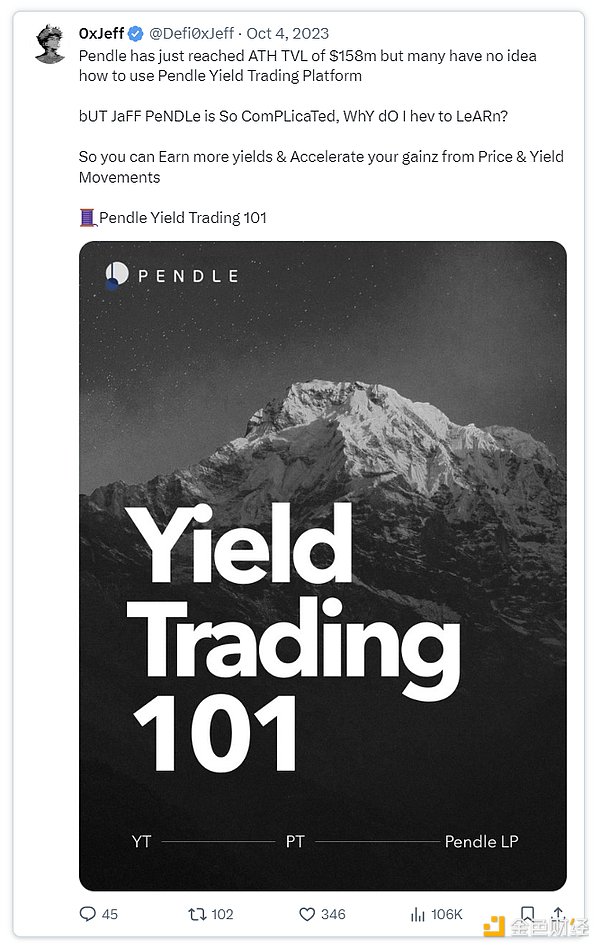
Author: 0xJeff, Steak Studio; Translation: Golden Finance xiaozou
Tokenization has always been an area that fascinates me Very fascinating concept. It may not seem complicated, but whenever something comes out in the form of tokenization, mindshare immediately shifts to it.
This article summarizes the details of some of the tokenization trends we've seen so far, how they're playing out, and what's likely to happen next:
1. Tokenization of assets
The initial tokenization trend.
Bitcoin created the first decentralized, secure, and transparent ledger system, paving the way for the digital representation of assets.
Then, Ethereum came out in 2015, introducing smart contracts that made assets programmable—whether real estate, art, or DeFi.
ETH’s current FDV is $470 billion. This is the scale of the impact that tokenization will have on assets.
2. Tokenization of art (NFTs)
The rise of NFTs will transform tokens into culture into the art world.
In 2017, projects such as CryptoPunks and CryptoKitties set off the NFT craze.
By 2021, NFT transaction volume will reach $13 billion as NFTs become the preferred way to represent digital art and collectibles.
Many collectibles, such as CryptoPunks, BAYC, Art Blocks, etc., will cost millions of dollars at their peak in 2021.
3. Tokenization of earnings
Another major change is the tokenization of earnings .
Pendle pioneered the idea of tokenizing future earnings in 2021.
It creates a platform for trading fixed and variable income Market, adding flexibility and liquidity to DeFi
Pendle will achieve true success with LSTs (liquid staking tokens) in 2023 and the points market in early 2024.
Today, the FDV of PENDLE token is $1.6 billion
4. Tokenization of AI agents
Now we see the tokenization of AI agents.
Virtuals has launched a platform where you can create and tokenize AI agents, effectively directing the cost of their development.
The AI agent narrative begins in October 2024, with Virtuals creating a market for agent ownership
Fast forward to the present: the FDV of VIRTUAL tokens has been reached. 2.5 billion US dollars.
5. Trend discovery
In all Across these categories—assets, art, income, AI agents—the pattern is clear: Pioneers in each category tend to experience rapid adoption and significant price activity.
So, the big question is: what’s next for tokenization?
Here are some ideas I'm looking at:
6. Tokenization of data
Vana is exploring DataDAOs and Data Liquidity Pools (DLPs: Data Liquidity Pools)
Users can contribute data to these data pools, retain ownership, and receive rewards based on the quality of their contributions.
Essentially, it will Data is transformed into a liquid, tradable asset
VANA token will be released on December 16th (listed on Binance). Be careful though, as the exact FDV is not yet known, but the idea of tokenizing data ownership can be a very big one. p>
7. Tokenization of attention
Kaito AI is working on the tokenization of attention in Web3. They have demonstrated the ability to generate and capture more attention through their platform mindshare dashboard and most recently Yap-to-Earn
Their "Yapper Rankings" inspire thought leaders to "yap" more, earn "Yap" points, and ultimately receive a KAITO token airdrop.
Basically, Yap = attention = KAITO token.
This is an interesting game about how Web3 redefines user stickiness.
8. AI App Tokenization
This feels like a natural extension of the AI agent trend.
With tools like Replit and the rise of the agent ecosystem, we are one step closer to personalized software creation.
Tokenized AI apps allow users to guide development and own part of the revenue generated by the app
Competitors in this field:
ALCHEMIST AI and Myshell are the main contenders. Both platforms allow developers to develop revenue-generating artificial intelligence applications and provide practical and scalable use cases.
Myshell goes a step further, allowing investors to directly invest in these applications and generate revenue from the future.Get a share of the proceeds. This model not only supports development but also aligns incentives between creators and investors.
9. Final thoughts
The tokenization trend will always produce new innovations and waves of adoption. But what’s fascinating about tokenization trends isn’t just the technology—it’s how they bring people together and shift attention to new opportunities.
What is the next big trend in tokenization? I'm not sure, but these are ideas worth paying attention to.










